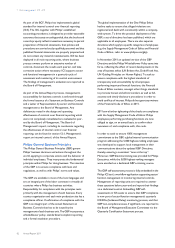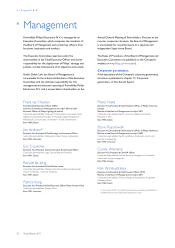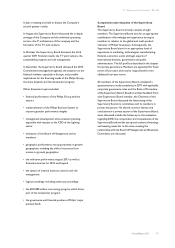Philips 2011 Annual Report Download - page 87
Download and view the complete annual report
Please find page 87 of the 2011 Philips annual report below. You can navigate through the pages in the report by either clicking on the pages listed below, or by using the keyword search tool below to find specific information within the annual report.7 Risk management 7.4 - 7.4
Annual Report 2011 87
supplier that is not able to meet its demand. Shortages or
delays could materially harm its business. Philips maintains
a regular review of its strategic and critical suppliers to
assess financial stability.
Most of Philips’ activities are conducted outside of the
Netherlands, and international operations bring
challenges. For example, production and procurement of
products and parts in Asian countries are increasing, and
this creates a risk that production and shipping of
products and parts could be interrupted by a natural
disaster, such as occurred in Japan in 2011. A general
shortage of materials, components or subcomponents as
a result of natural disasters also bears the risk of
unforeseeable fluctuations in prices and demand, which
could have a material adverse affect on its financial
condition and operating results.
Sectors purchase raw materials including so-called rare
earth metals, copper, steel, aluminum and oil, which
exposes them to fluctuations in energy and raw material
prices. In recent times, commodities have been subject to
volatile markets, and such volatility is expected to
continue. If we are not able to compensate for our
increased costs or pass them on to customers, price
increases could have a material adverse impact on Philips’
results. In contrast, in times of falling commodity prices,
Philips may not fully profit from such price decreases as
Philips attempts to reduce the risk of rising commodity
prices by several means, such as long-term contracting or
physical and financial hedging. In addition to the price
pressure that Philips may face from our customers
expecting to benefit from falling commodity prices or
adverse market conditions, this could also adversely affect
its financial condition and operating results.
Due to the fact that Philips is dependent on its personnel
for leadership and specialized skills, the loss of its ability
to attract and retain such personnel would have an
adverse effect on its business.
The attraction and retention of talented employees in
sales and marketing, research and development, finance
and general management, as well as of highly specialized
technical personnel, especially in transferring technologies
to low-cost countries, is critical to Philips’ success. This is
particularly valid in times of economic recovery. The loss
of specialized skills could also result in business
interruptions. There can be no assurance that Philips will
continue to be successful in attracting and retaining all the
highly qualified employees and key personnel needed in
the future.
Diversity in information technology (IT) could result in
ineffective or inefficient business management. IT
outsourcing and off-shoring strategies could result in
complexities in service delivery and contract
management. Furthermore, we observe a global increase
in IT security threats and higher levels of professionalism
in computer crime, posing a risk to the confidentiality,
availability and integrity of data and information.
Philips is engaged in a continuous drive to create a more
open, standardized and consequently, more cost-
effective IT landscape. This is leading to an approach
involving further outsourcing, off-shoring,
commoditization and ongoing reduction in the number of
IT systems. The global increase in security threats and
higher levels of professionalism in computer crime have
raised the company’s awareness of the importance of
effective IT security measures, including proper identity
management processes to protect against unauthorized
systems access. Nevertheless, Philips’ systems, networks,
products, solutions and services remain potentially
vulnerable to attacks, which could potentially lead to the
leakage of confidential information, improper use of its
systems and networks or defective products, which could
in turn adversely affect Philips’ financial condition and
operating results. In recent years, the risks that we and
other companies face from cyber attacks have increased
significantly. The objectives of these cyber attacks vary
widely and may include, among things, disruption of
operations including provision of services to customers
or theft of intellectual property or other sensitive
information belonging to us or other business
partners. Successful cyber attacks may result in substantial
costs and other negative consequences, which may
include, but are not limited to, lost revenues, reputational
damage, remediation costs, and other liabilities to
customers and partners. Furthermore, enhanced
protection measures can involve significant costs. We
have experienced cyber attacks but to date have not
incurred any significant damage as a result. However,
there can be no assurance that in the future Philips will be
as successful in avoiding damages from cyber attacks.
Additionally, the integration of new companies and
successful outsourcing of business processes are highly
dependent on secure and well-controlled IT systems.
Warranty and product liability claims against Philips could
cause Philips to incur significant costs and affect Philips’
results as well as its reputation and relationships with key
customers.
Philips is from time to time subject to warranty and
product liability claims with regard to product
performance and effects. Philips could incur product
liability losses as a result of repair and replacement costs
in response to customer complaints or in connection with
























